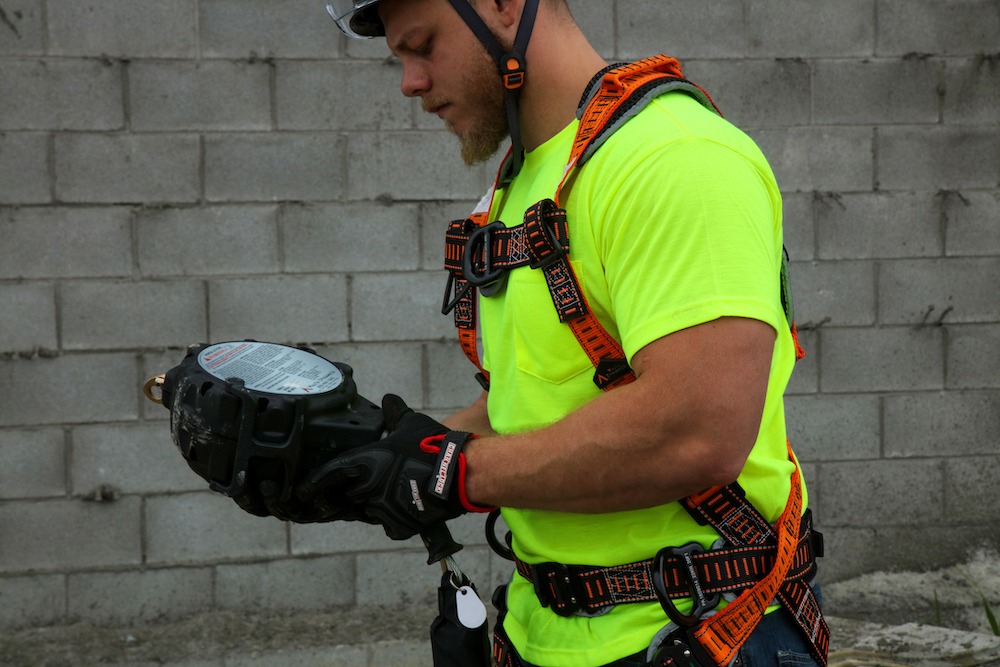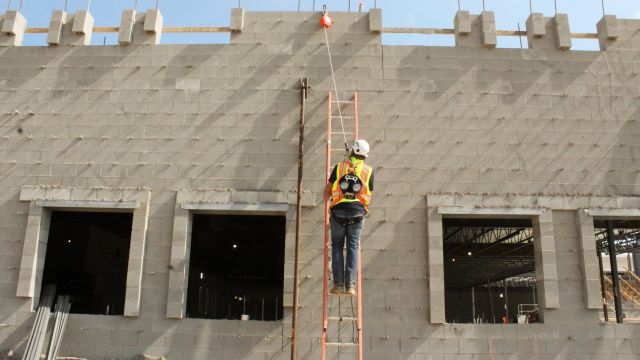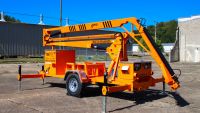Fall Restraint vs. Fall Arrest: What’s the Difference?
By Uma Basso
Workers face a myriad of dangers when on the construction site. Heavy machinery, dangerous equipment, dust, and other toxic materials are common hazards encountered on the job site. For a work crew whose job requires them to be in elevated positions, such as roofs, scaffolds, or ladders, the threat of severe injury from a fall is a very real danger.
Fall injuries can be particularly devastating for a worker. A fall may result in head injuries, broken bones, and other life-altering damage. Injuries from a fall can be fatal.
Regardless of the amount of time that a worker may spend at a higher elevation, the severity of the injuries that may result from a fall makes it critical to have an active fall protection system in place.
Staying Safe from a Fall
OSHA requires a fall protection system to be in place for elevations of six feet in the construction industry. Regardless of the distance from the ground, masons and contractors are also required by OSHA to have a fall protection system for crews working over hazardous machinery and equipment to prevent injury.
There are two primary active fall protection plans that help keep your work crew safe at higher elevations: a fall restraint system and a fall arrest system. While the names sound similar, these fall protection systems have vastly different purposes. Choosing between the two depends largely on hazards that a worker may face while on the job.
What is a Fall Restraint System?

Fall restraint systems are designed to prevent a fall from happening in the first place. A restraint system is best for a worker who does not need to approach a fall hazard on the job.
With this type of system, a worker is harnessed to a fixed-length lanyard, which is anchored to a secure point. The length of the lanyard is such that worker can do their job, yet it keeps them from getting too close to the fall hazard. Although the length of the lanyard will limit a worker's movement, a fall restraint system can significantly lessen the chance of injury.
What is a Fall Arrest System?
A fall arrest system is employed when a worker cannot be prevented from reaching a fall hazard. The fall arrest system uses the same general components as you will find in a fall restraint system. However, this system is designed to sense when a worker is falling and locks to arrest, or stop, the fall. An arrest system may leave a worker suspended until they can be lowered to safety.
An arrest system typically consists of an anchor point, or a series of anchor points, a body harness, and a shock-absorbing or self-retracting lanyard. Fall arrest systems give workers more flexibility to move about while on the job. An arrest system may be employed for elevated surfaces that are so narrow that a worker has no choice but to get close to the edge.
Is a Rescue Plan Necessary?
Even with a fall arrest system, a contractor or company must have a rescue plan if the equipment is deployed. While the arrest system is made to catch someone when they fall, a lengthy suspension can be dangerous. In some cases, suspended workers may be able to lower themselves by using a self-retracting lifeline.
Yet other situations may require outside help. Whether the plan is to call emergency personnel or have members from the onsite work crew use rescue equipment, such as portable ladders and ropes, a contractor should have a written rescue plan in place to help keep their work crew safe.
While there may be less need for a rescue plan when using a fall restraint system, it is still a good idea to have one in place.
A Fall Restraint or Fall Arrest System?
Both fall restraint and fall arrest systems have their applications on the job site. A fall restraint system will likely reduce the chance of injury, but it limits worker movement. Conversely, the fall arrest system gives workers more flexibility to move about, yet there is a possibility of injury.
Since a fall restraint system prevents the worker from reaching a fall hazard, it is the preferable method to avoid injury. In some cases, a fall restraint system may be required to meet specific distance rules. For example, in a job where there is limited ground clearance below the worker may call for the use of a fall restraint system to meet safety regulations.
A fall arrest system should be used when it is not possible to restrict workers from reaching the risk of falling. An arrest system would be employed for workers who need to climb up and down ladders or must get close to the edge of a roof or building to work. A fall arrest system may be required for jobs with fragile walking or delicate surfaces that could break when stepped on.
Common Issues Encountered When Using Fall Protection Systems
While it is critical to employ the appropriate fall protection system based on the conditions of the job, there are other steps a contractor should take to ensure the effectiveness of a fall protection plan. These include:
Proper training: Workers should be trained on using and caring for the equipment.
Correct weight load: The components of a fall protection system have weight limitations. Excessive weight can cause undue stress to the system and may cause it to malfunction. Workers should know what these limitations are and take the proper steps to ensure that they do not exceed the maximum weight.
Correct equipment usage: Even if you have the right equipment in place, it may be ineffective if it is misused. It is critical to follow and adhere to the specifications of the fall protection system. For example, a lanyard that is longer than the design calls for could cause someone to get hurt in case of a fall.
Perform regular maintenance and inspections: It is a good idea to visually inspect equipment before each use. The constant wear and tear placed on the equipment weaken it over time. High usage and stress can cause your fall protection equipment to malfunction at the worst time. Fall protection equipment should be in good working order and free of dust or dirt. To keep your workers safe and make sure the equipment works as it should, you should regularly inspect and maintain your equipment.
Proper storage: Fall protection equipment should be stored in a dry place and protected from such weather elements as extreme heat or cold.
Keeping the Work Crew Safe on the Job
Falls can result in severe injuries to workers. Falls are one of the most common ways for workers to be injured on the job site.
Whether working on a ladder or an overhead platform, it is critical to have an appropriate fall protection system in place to keep your crew safe. Contractors and masons should evaluate the fall risks presented on the job site to determine if a fall restraint or fall arrest system is appropriate. Proper installation, training, and storage procedures are key to an effective fall protection system.
About the Author




















